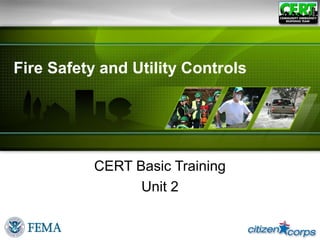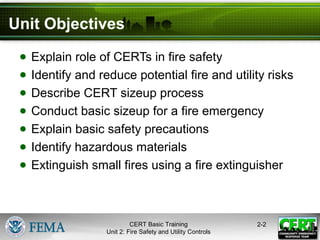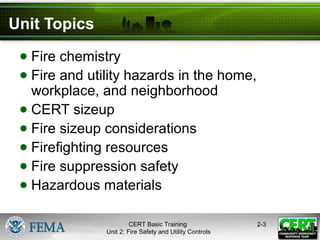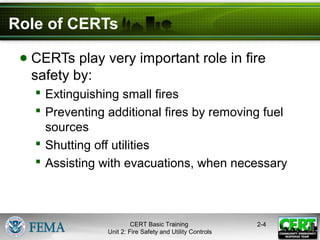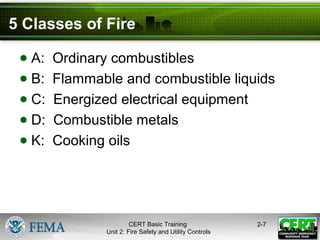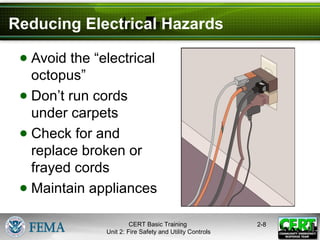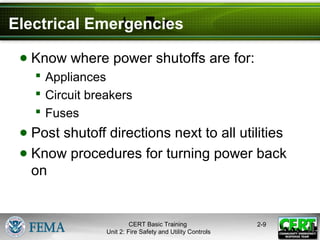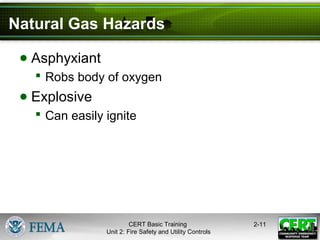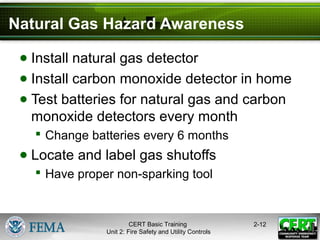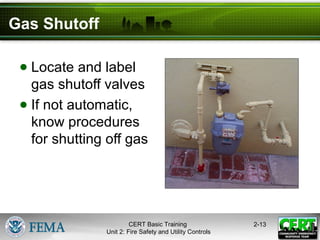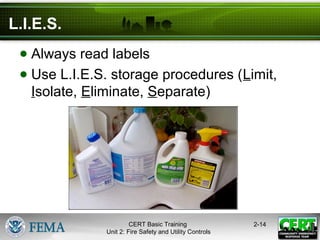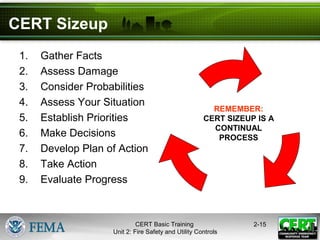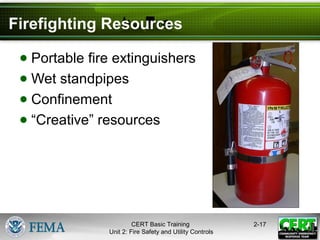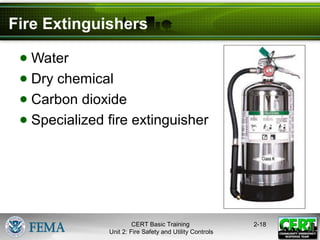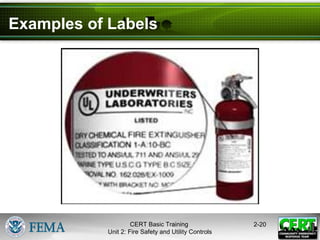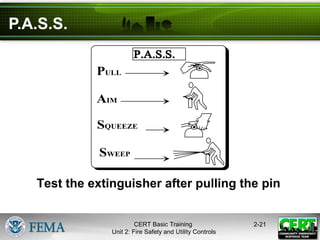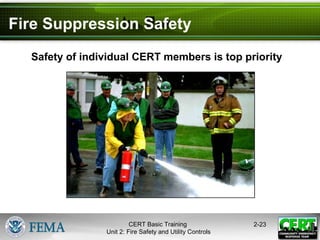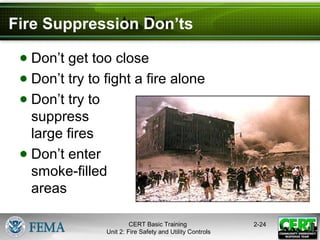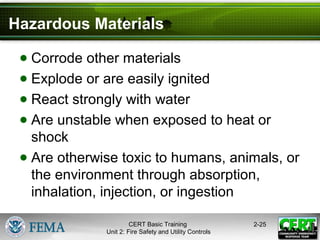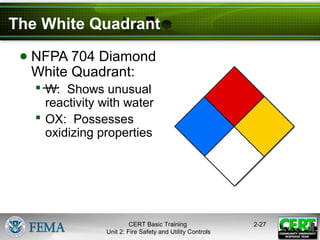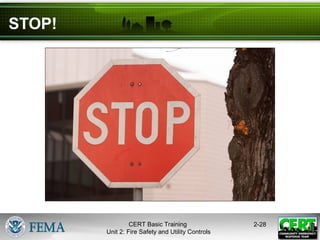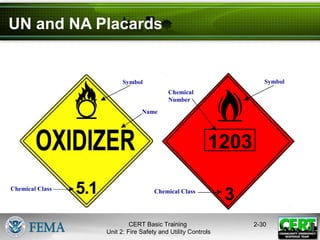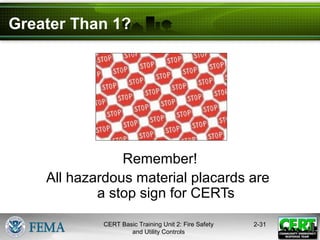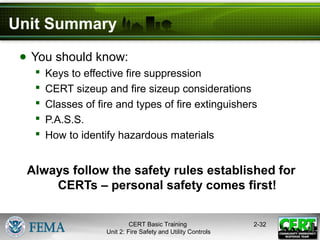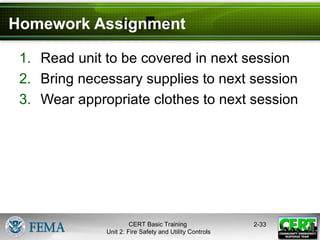Cert unit2 jan2011
- 1. Fire Safety and Utility Controls CERT Basic Training Unit 2
- 2. CERT Basic Training Unit 2: Fire Safety and Utility Controls 2-2 Unit Objectives â Explain role of CERTs in fire safety â Identify and reduce potential fire and utility risks â Describe CERT sizeup process â Conduct basic sizeup for a fire emergency â Explain basic safety precautions â Identify hazardous materials â Extinguish small fires using a fire extinguisher
- 3. CERT Basic Training Unit 2: Fire Safety and Utility Controls 2-3 Unit Topics â Fire chemistry â Fire and utility hazards in the home, workplace, and neighborhood â CERT sizeup â Fire sizeup considerations â Firefighting resources â Fire suppression safety â Hazardous materials
- 4. CERT Basic Training Unit 2: Fire Safety and Utility Controls 2-4 Role of CERTs â CERTs play very important role in fire safety by: ï§ Extinguishing small fires ï§ Preventing additional fires by removing fuel sources ï§ Shutting off utilities ï§ Assisting with evacuations, when necessary
- 5. CERT Basic Training Unit 2: Fire Safety and Utility Controls 2-5 CERT Priorities â Help in emergencies before professional responders arrive â Rescuer safety is number one priority ï§ Always work with a buddy ï§ Always wear safety equipment CERT Goal: Do the greatest good for the greatest number
- 6. CERT Basic Training Unit 2: Fire Safety and Utility Controls 2-6 The Fire Triangle â Heat â Fuel â Oxygen
- 7. CERT Basic Training Unit 2: Fire Safety and Utility Controls 2-7 5 Classes of Fire â A: Ordinary combustibles â B: Flammable and combustible liquids â C: Energized electrical equipment â D: Combustible metals â K: Cooking oils
- 8. CERT Basic Training Unit 2: Fire Safety and Utility Controls 2-8 Reducing Electrical Hazards â Avoid the âelectrical octopusâ â Donât run cords under carpets â Check for and replace broken or frayed cords â Maintain appliances
- 9. CERT Basic Training Unit 2: Fire Safety and Utility Controls 2-9 Electrical Emergencies â Know where power shutoffs are for: ï§ Appliances ï§ Circuit breakers ï§ Fuses â Post shutoff directions next to all utilities â Know procedures for turning power back on
- 10. CERT Basic Training Unit 2: Fire Safety and Utility Controls 2-10 Shutoff Procedures â Fuse box with shutoff â Circuit box with shutoff
- 11. CERT Basic Training Unit 2: Fire Safety and Utility Controls 2-11 Natural Gas Hazards â Asphyxiant ï§ Robs body of oxygen â Explosive ï§ Can easily ignite
- 12. CERT Basic Training Unit 2: Fire Safety and Utility Controls 2-12 Natural Gas Hazard Awareness â Install natural gas detector â Install carbon monoxide detector in home â Test batteries for natural gas and carbon monoxide detectors every month ï§ Change batteries every 6 months â Locate and label gas shutoffs ï§ Have proper non-sparking tool
- 13. CERT Basic Training Unit 2: Fire Safety and Utility Controls 2-13 Gas Shutoff â Locate and label gas shutoff valves â If not automatic, know procedures for shutting off gas
- 14. CERT Basic Training Unit 2: Fire Safety and Utility Controls 2-14 L.I.E.S. â Always read labels â Use L.I.E.S. storage procedures (Limit, Isolate, Eliminate, Separate)
- 15. CERT Basic Training Unit 2: Fire Safety and Utility Controls 2-15 CERT Sizeup 1. Gather Facts 2. Assess Damage 3. Consider Probabilities 4. Assess Your Situation 5. Establish Priorities 6. Make Decisions 7. Develop Plan of Action 8. Take Action 9. Evaluate Progress REMEMBER: CERT SIZEUP IS A CONTINUAL PROCESS
- 16. CERT Basic Training Unit 2: Fire Safety and Utility Controls 2-16 CERT Fire Sizeup â Helps responders decide: ï§ Whether to attempt to suppress a fire ï§ A plan of action â Answers these questions: ï§ Do my buddy and I have the right equipment? ï§ Are there other hazards? ï§ Is the building structurally damaged? ï§ Can my buddy and I escape? ï§ Can my buddy and I fight the fire safely? Remember: The safety of individual CERT members is always the top priority
- 17. CERT Basic Training Unit 2: Fire Safety and Utility Controls 2-17 Firefighting Resources â Portable fire extinguishers â Wet standpipes â Confinement â âCreativeâ resources
- 18. CERT Basic Training Unit 2: Fire Safety and Utility Controls 2-18 Fire Extinguishers â Water â Dry chemical â Carbon dioxide â Specialized fire extinguisher
- 19. CERT Basic Training Unit 2: Fire Safety and Utility Controls 2-19 Extinguisher Rating/Labeling â Labels show types of fires that extinguisher is used for: ï§ Class A fire ratings: 1A to 40A ï§ Class B fire ratings: 1B to 640B â Higher number on label = greater amount of extinguishing agent
- 20. CERT Basic Training Unit 2: Fire Safety and Utility Controls 2-20 Examples of Labels
- 21. CERT Basic Training Unit 2: Fire Safety and Utility Controls 2-21 P.A.S.S. PULL AIM SQUEEZE SWEEP Test the extinguisher after pulling the pin
- 22. CERT Basic Training Unit 2: Fire Safety and Utility Controls 2-22 Interior Wet Standpipes â Usually in commercial buildings or apartments â Work in two- person teams when using wet standpipes
- 23. CERT Basic Training Unit 2: Fire Safety and Utility Controls 2-23 Fire Suppression Safety Safety of individual CERT members is top priority
- 24. CERT Basic Training Unit 2: Fire Safety and Utility Controls 2-24 Fire Suppression Donâts â Donât get too close â Donât try to fight a fire alone â Donât try to suppress large fires â Donât enter smoke-filled areas
- 25. CERT Basic Training Unit 2: Fire Safety and Utility Controls 2-25 Hazardous Materials â Corrode other materials â Explode or are easily ignited â React strongly with water â Are unstable when exposed to heat or shock â Are otherwise toxic to humans, animals, or the environment through absorption, inhalation, injection, or ingestion
- 26. CERT Basic Training Unit 2: Fire Safety and Utility Controls 2-26 Identifying Stored Hazmats
- 27. CERT Basic Training Unit 2: Fire Safety and Utility Controls 2-27 The White Quadrant â NFPA 704 Diamond White Quadrant: ï§ W: Shows unusual reactivity with water ï§ OX: Possesses oxidizing properties
- 28. CERT Basic Training Unit 2: Fire Safety and Utility Controls 2-28 STOP!
- 29. CERT Basic Training Unit 2: Fire Safety and Utility Controls 2-29 Hazmats in Transit Orange Red White Red Red & White Red & White Blue Yellow White Yellow & White Black & White
- 30. CERT Basic Training Unit 2: Fire Safety and Utility Controls 2-30 UN and NA Placards 1203 3 Name Chemical Class Symbol Chemical Number Chemical Class Symbol
- 31. CERT Basic Training Unit 2: Fire Safety and Utility Controls 2-31 Greater Than 1? Remember! All hazardous material placards are a stop sign for CERTs
- 32. CERT Basic Training Unit 2: Fire Safety and Utility Controls 2-32 Unit Summary â You should know: ï§ Keys to effective fire suppression ï§ CERT sizeup and fire sizeup considerations ï§ Classes of fire and types of fire extinguishers ï§ P.A.S.S. ï§ How to identify hazardous materials Always follow the safety rules established for CERTs â personal safety comes first!
- 33. CERT Basic Training Unit 2: Fire Safety and Utility Controls 2-33 Homework Assignment 1. Read unit to be covered in next session 2. Bring necessary supplies to next session 3. Wear appropriate clothes to next session

